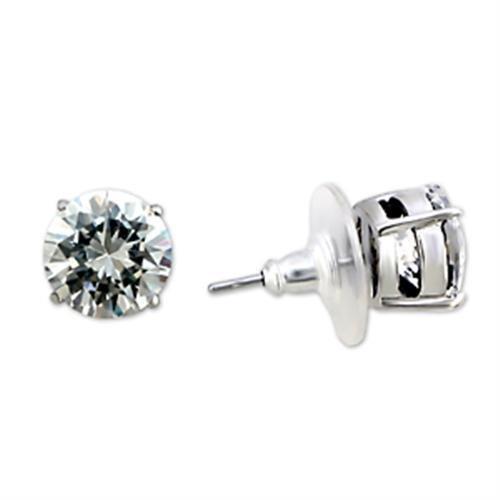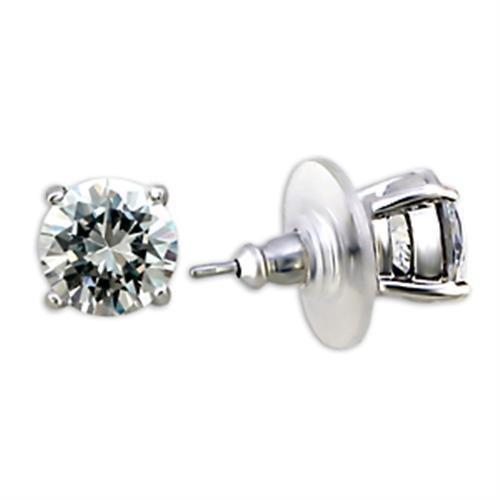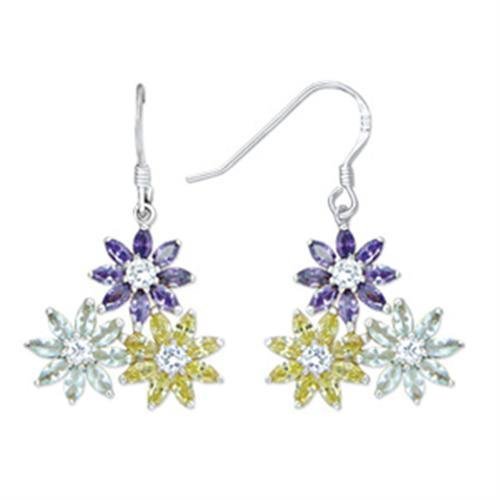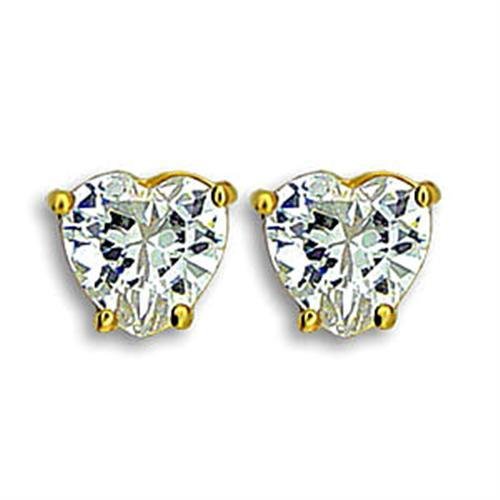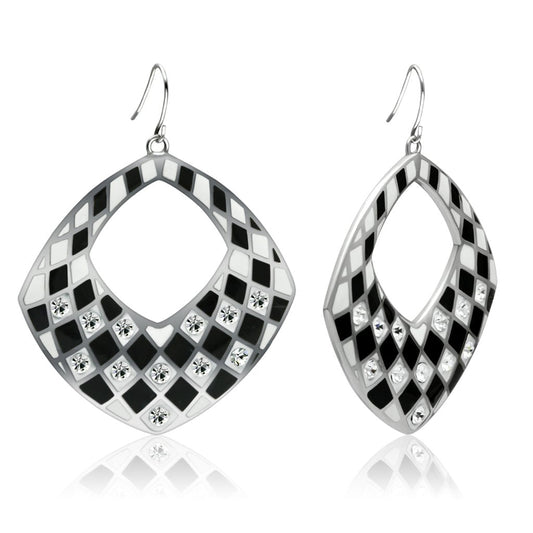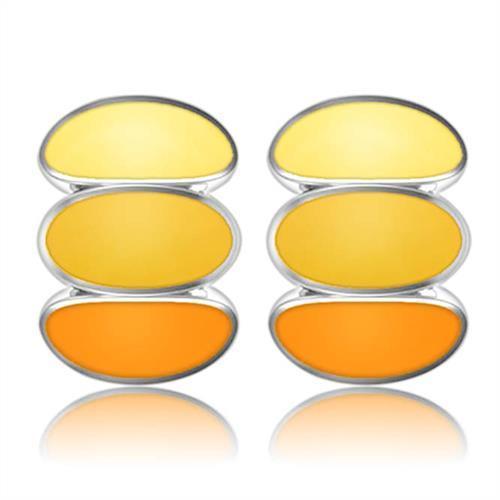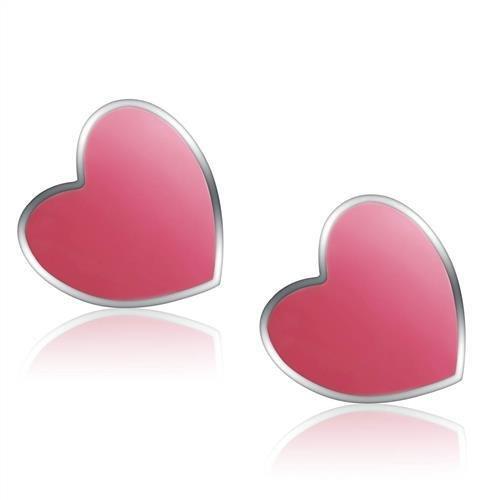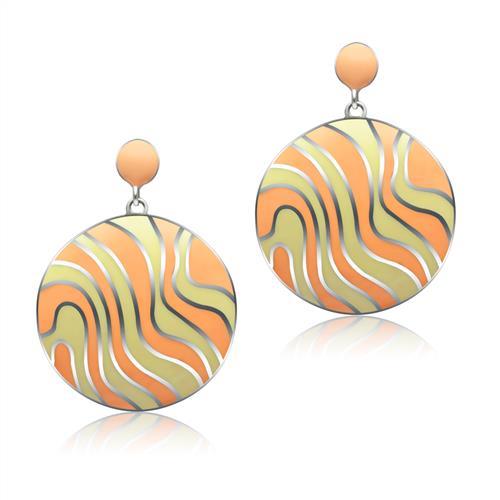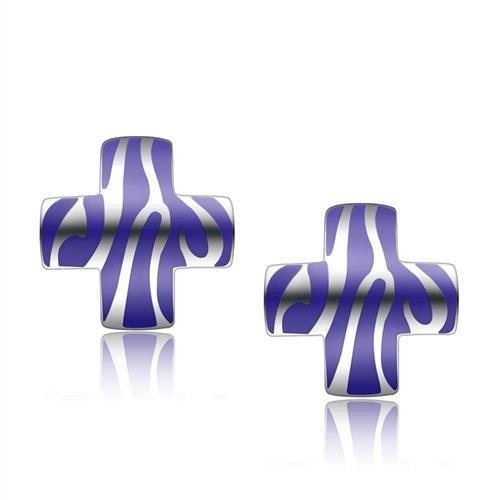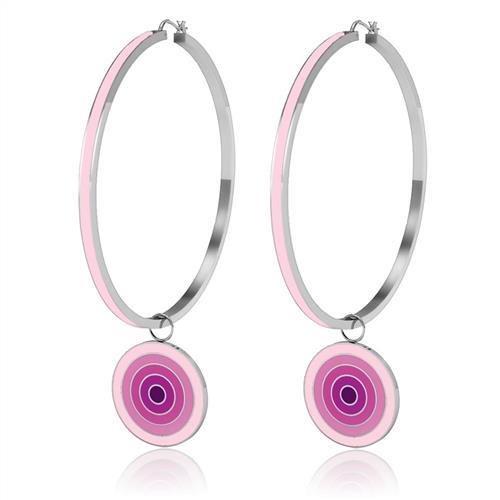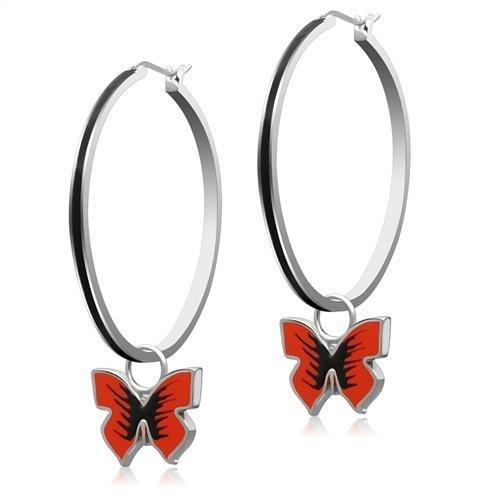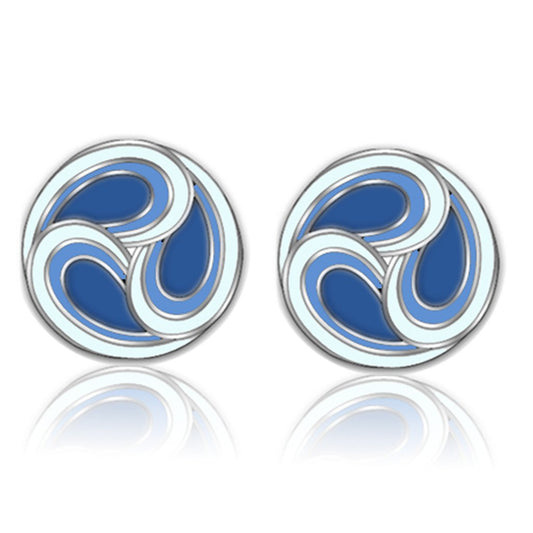When it comes to the best tarnish-free jewelry, it's all about choosing pieces made from durable, non-reactive materials like stainless steel, titanium, and gold-filled metals. These materials are built to resist the chemical reactions that cause discoloration, ensuring your favorite pieces stay vibrant and shiny with barely any upkeep.
Why Some Jewelry Tarnishes and Others Don't
Have you ever opened your jewelry box, excited to wear a favorite necklace, only to find it looking dull and discolored? That frustrating dark film is tarnish, and it’s not a sign of a cheap or poorly made piece—it’s just simple chemistry at work.
Think of it like a sliced apple turning brown when left out on the counter. A very similar chemical process happens to certain metals when they're exposed to the elements.
Tarnish is the result of a chemical reaction that happens when metals like silver and copper come into contact with sulfur compounds floating in the air. This interaction creates a thin layer of corrosion on the surface, which is what we see as that dark, dull coating. It's crucial to know that tarnish is not the same as rust. Rust actually eats away at and weakens iron-based metals, while tarnish only affects the surface layer and can often be polished away.
What Speeds Up the Tarnish Process
Several everyday factors can kick this chemical reaction into high gear, making your jewelry look old before its time. Getting to know these culprits is the first step toward choosing pieces that will last and learning how to care for them the right way.
This diagram breaks down the main environmental and personal factors that cause jewelry to tarnish.
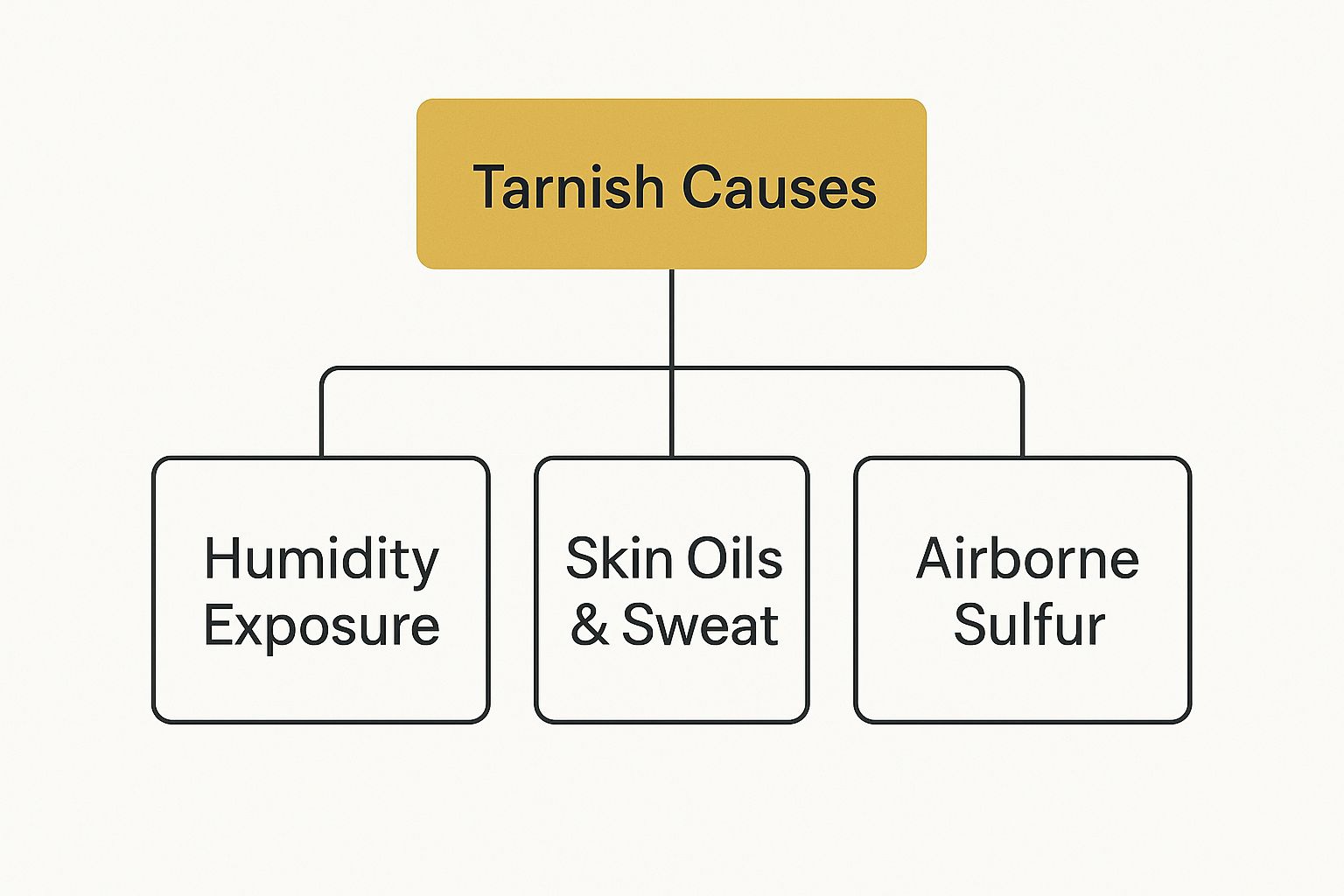
As you can see, the biggest enemies of shiny jewelry are moisture, chemicals from our own bodies, and various elements in the air around us.
The most common culprits are humidity, which traps sulfur gases against the metal, and direct contact with chemicals found in perfumes, lotions, and even our own skin’s oils and sweat.
For instance, putting on a silver bracelet right after applying lotion can trap both moisture and chemicals against the metal, fast-tracking discoloration. In the same way, storing your jewelry in a humid bathroom is one of the quickest ways to invite tarnish to the party.
For a deeper dive into the science, you can explore our detailed guide on what causes jewelry to tarnish. By understanding what causes this reaction, you can make smarter choices about both the jewelry you buy and the habits you build to protect it.
Your Guide to the Best Tarnish Resistant Materials
Navigating the world of jewelry materials can feel like learning a new language. But when it comes to finding pieces that won't tarnish, a few key players stand out from the crowd. These are the champions of everyday wear, giving you that brilliant, lasting shine without needing constant polishing.
Let's cut through the confusion and get straight to the materials that actually deliver on their promise. Understanding what makes each one special is the key to choosing jewelry that fits your lifestyle, budget, and peace of mind.
Stainless Steel: The Everyday Powerhouse
When you need jewelry that’s both affordable and practically indestructible, stainless steel is a true superstar. Think of it as having built-in armor. Its secret weapon is chromium, an element in the alloy that forms an invisible protective layer on the surface. This shield is what makes it so resistant to scratches, corrosion, and—most importantly—tarnish.
High-quality grades like 316L stainless steel, often called surgical steel, are not only tough but also hypoallergenic. This makes them a fantastic choice for anyone with sensitive skin who doesn't want to compromise on durability. Our collection of stainless steel necklaces and bracelets are designed for exactly this kind of worry-free, daily wear.
Titanium: The Lightweight Champion
Titanium is another top contender, famous for being incredibly strong yet surprisingly lightweight. It’s a biocompatible metal, which means it’s non-toxic and won't cause a reaction with your body. That's why it's a go-to for medical implants and an absolute dream for anyone with metal allergies.
Unlike other metals that need a special coating, titanium’s tarnish resistance is all-natural. It’s immune to corrosion from sweat, saltwater, and most chemicals, making it perfect for rings and bracelets you plan on wearing 24/7.
The demand for these durable materials reflects a major shift in how we shop for jewelry. The global jewelry market is valued at over $350 billion, with huge growth in accessible luxury where tarnish-free metals are thriving. In fact, 42% of consumers under 35 prefer hypoallergenic, tarnish-resistant options for their durability and better pricing. You can learn more about the latest jewelry market trends.
Gold Plated vs. Gold Filled: Explained
Understanding the difference between gold-plated and gold-filled jewelry is crucial. It’s not just about looks; it’s about how long that beautiful gold finish will last.
-
Gold-Plated Jewelry: This process involves applying an incredibly thin layer of gold over a base metal like brass or copper. It’s a great, affordable way to get that golden shine, but that thin layer can eventually wear away, exposing the base metal underneath to tarnishing.
-
Gold-Filled Jewelry: This is a much more durable option. It involves heat-bonding a thick layer of solid gold to a base metal core. The gold content is significantly higher—legally, it has to be at least 5% of the item's total weight. This creates a resilient, tarnish-resistant piece that offers the best value next to solid gold itself.
For those who love the bright, cool luster of platinum but want a more budget-friendly choice, rhodium plating over sterling silver is an excellent trick of the trade. Our guide explains exactly what rhodium plating is and why it’s so popular for keeping silver pieces brilliant and tarnish-free.
Tarnish Resistant Jewelry Materials Compared
To make things even easier, here’s a quick side-by-side look at the best materials for keeping your jewelry looking brand new. This should help you pinpoint the perfect option for your needs.
| Material | Tarnish Resistance | Hypoallergenic | Affordability | Best For |
|---|---|---|---|---|
| Stainless Steel | Excellent | Yes (316L grade) | Very Affordable | Everyday wear, minimalist styles, and budget-friendly pieces. |
| Titanium | Excellent | Yes | Mid-Range | Active lifestyles, wedding bands, and anyone with severe metal allergies. |
| Gold Filled | Very Good | Depends on Base | Mid-Range | Achieving the look of solid gold with great durability and value. |
| Rhodium Plated | Good (until it wears off) | Yes | Affordable | Giving sterling silver a platinum look and temporary tarnish protection. |
Ultimately, choosing the right material comes down to balancing your budget, lifestyle, and aesthetic preferences. Whether you go for the rugged reliability of stainless steel or the lasting glow of gold-filled jewelry, you can find a beautiful piece that won't let you down.
How to Spot High-Quality Tarnish-Free Jewelry
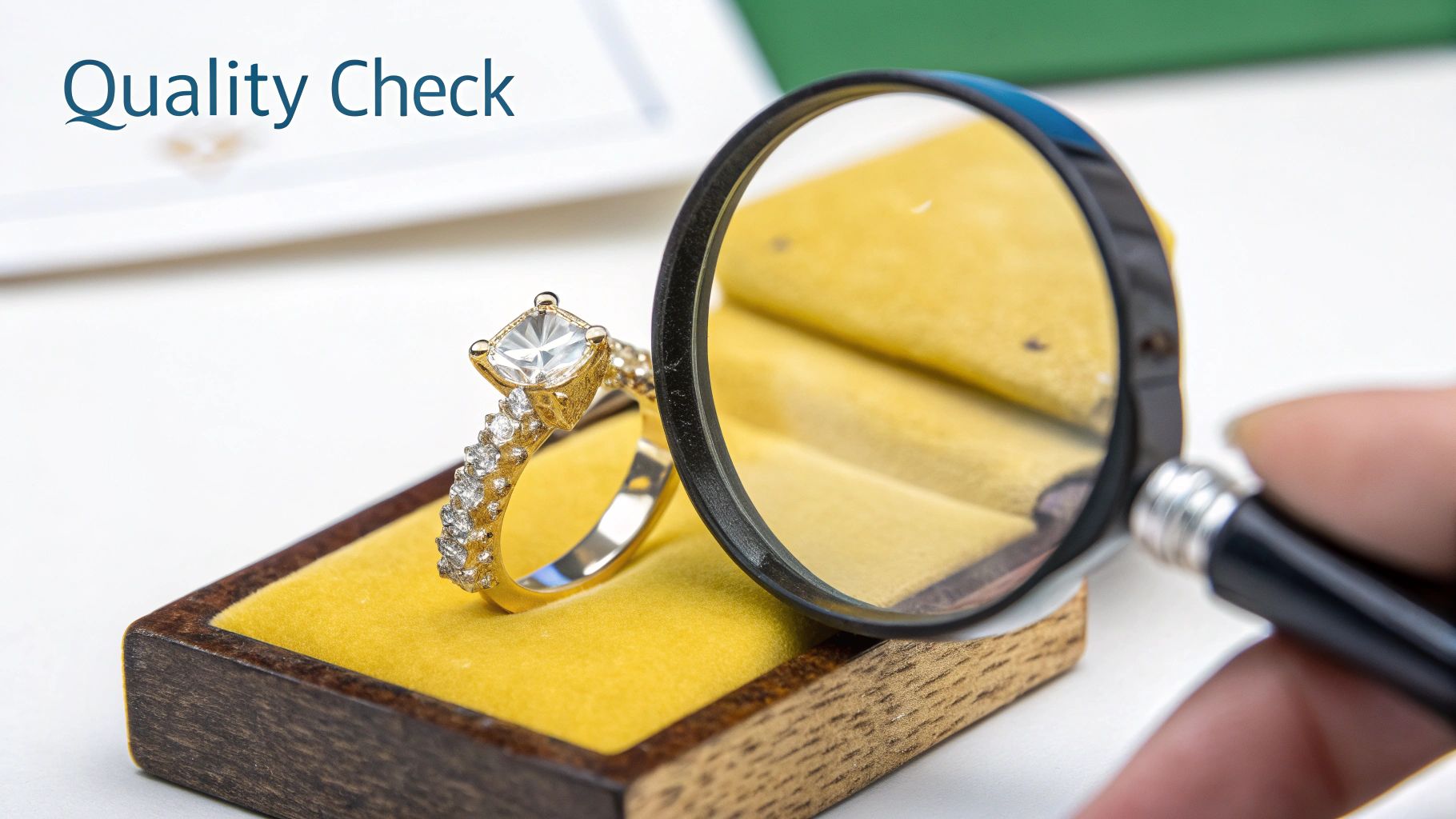
Navigating the jewelry market can feel a little overwhelming, but knowing what to look for transforms you from a hopeful buyer into a confident one. Spotting the best tarnish-free jewelry is about looking past the initial sparkle and digging into the small details that signal true quality and durability. Think of this as your pre-purchase checklist for finding pieces built to last.
The first step? Become a material detective. High-quality pieces will always proudly display what they're made of. Look for tiny, engraved stamps on the clasp or another out-of-the-way spot on the jewelry.
- For stainless steel, you’ll want to see markings like ‘316L’ or ‘Surgical Steel’. This specific grade is a powerhouse, known for its top-tier corrosion resistance and hypoallergenic properties.
- For sterling silver, the classic ‘925’ stamp is your green light. It confirms the piece is 92.5% pure silver, the industry standard for quality.
These little stamps are the brand's guarantee of the metal's purity and composition, giving you a huge dose of peace of mind.
Beyond the Metal: The Details Matter
True craftsmanship always shows up in the finer points. A secure, well-made clasp is one of the most important (and often overlooked) features. Check for lobster clasps or spring rings that feel solid and operate smoothly. A flimsy clasp is usually the first part of a necklace or bracelet to fail.
Next, run your fingers over the finish. A quality piece should feel perfectly smooth and seamless, with no rough edges or messy soldering marks. This tells you it was carefully polished with great attention to detail, so it won't snag your favorite sweater or irritate your skin.
When you're hunting for pieces that will last, look for terms like hypoallergenic. It’s often a sign of superior materials that resist both tarnishing and skin reactions. Exploring hypoallergenic jewelry options is a great place to start your search for durable and comfortable accessories.
A key indicator of quality for plated jewelry is the thickness of the plating, often measured in microns. While budget pieces might have a thin "flash plating" of less than 0.5 microns, durable, high-quality items will feature a thicker layer—ideally 1 to 2.5 microns—which significantly extends its tarnish-free lifespan.
Using Social Proof to Your Advantage
Finally, never underestimate the power of customer reviews and a brand’s transparency. Reputable brands are always open about their materials and how their jewelry is made. Look for product descriptions that get specific, telling you exactly which metals and plating techniques they use.
Customer reviews offer priceless, real-world insights into how a piece actually wears over time. Pay close attention to comments that mention long-term use, especially from people who've worn the jewelry in water or during daily activities without it losing its shine. This kind of feedback is gold.
Simple Habits to Keep Your Jewelry Looking New
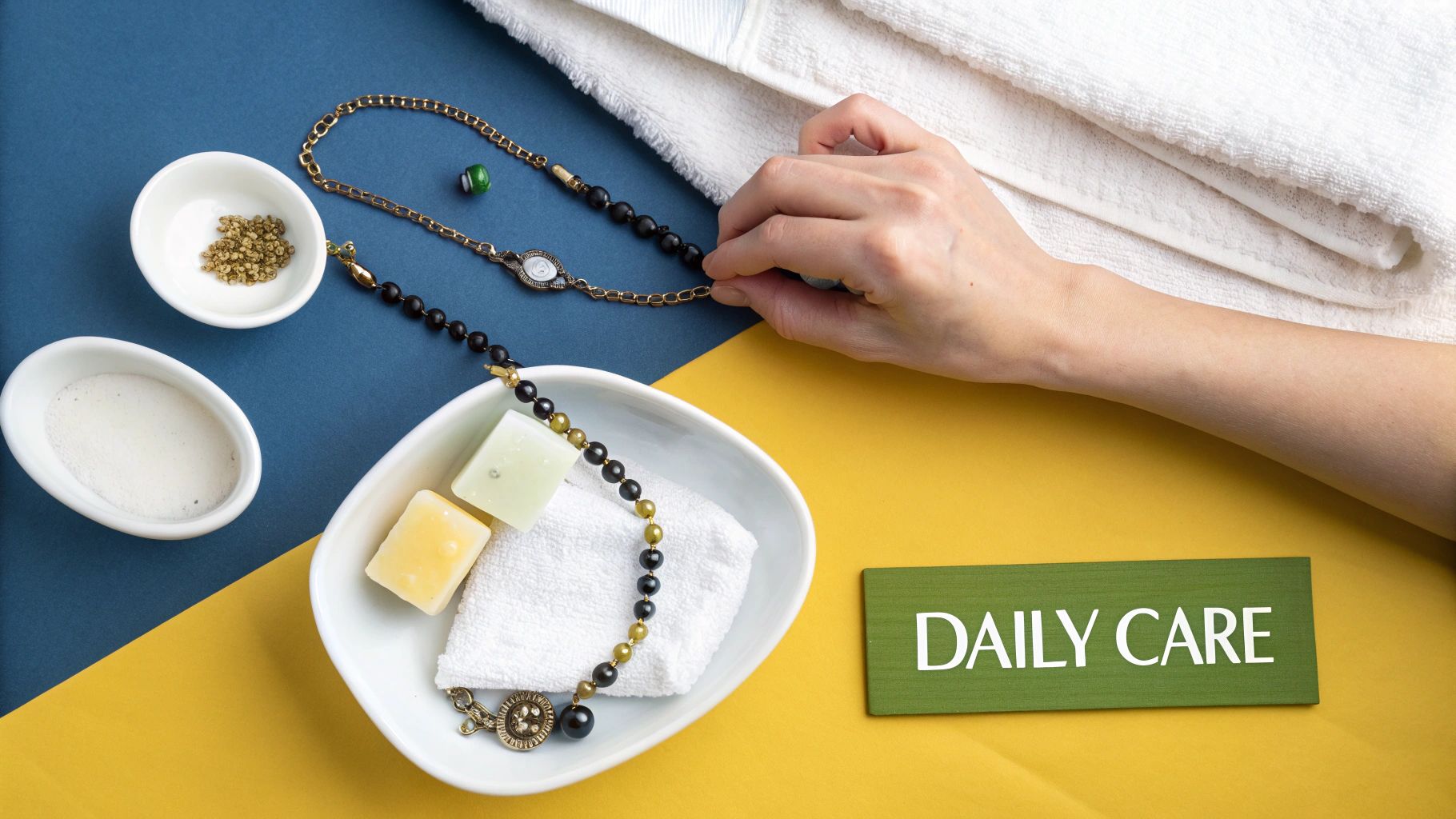
Even the most resilient tarnish-free jewelry needs a little love. The good news? Keeping that fresh-out-of-the-box sparkle doesn’t mean complicated routines or pricey products. It’s all about building a few simple, mindful habits into your day.
These small actions make a monumental difference. Think of it like skincare; a consistent daily routine beats an occasional, aggressive treatment every time. The same logic applies to keeping your favorite pieces looking pristine.
Your Daily Jewelry Care Routine
The easiest trick in the book is the "last on, first off" rule. Your jewelry should be the absolute final touch you add to your look—after you’ve spritzed your perfume and applied lotions or hairspray. These products are loaded with chemicals that can speed up discoloration and dull the finish on even the best materials.
Then, at the end of the day, make taking off your jewelry the very first thing you do. This simple step minimizes its exposure to the day's sweat and oils, which are primary culprits behind tarnish. A quick wipe with a soft, dry cloth before putting it away is the perfect finishing touch.
Storing your jewelry correctly is just as crucial as how you wear it. Tossing pieces into a drawer together is an invitation for scratches and tangles. Instead, keep each item in its own soft pouch or a lined jewelry box to protect its surface.
Simple and Safe Cleaning Methods
For a gentle yet effective clean, you don't need to get fancy. A simple bath of warm water mixed with a few drops of mild dish soap is all it takes to wash away daily grime.
Follow this easy, three-step process for a quick refresh:
- Soak Briefly: Let your jewelry sit in the soapy water for just a few minutes. This is enough to loosen any dirt or oil buildup.
- Gently Scrub: Grab a soft-bristled toothbrush to carefully clean around clasps, settings, and other detailed areas where gunk likes to hide.
- Rinse and Dry: Rinse the piece thoroughly under clean water and pat it completely dry with a soft, lint-free cloth before you wear it or put it away.
It's critical to steer clear of harsh chemicals like bleach or abrasive cleaners like toothpaste—they can permanently damage the metal's finish. For more specialized advice, especially when dealing with different metals, check out our in-depth guide on how to clean sterling silver jewelry to learn some expert techniques.
How Tarnish-Free Jewelry Fits Modern Trends
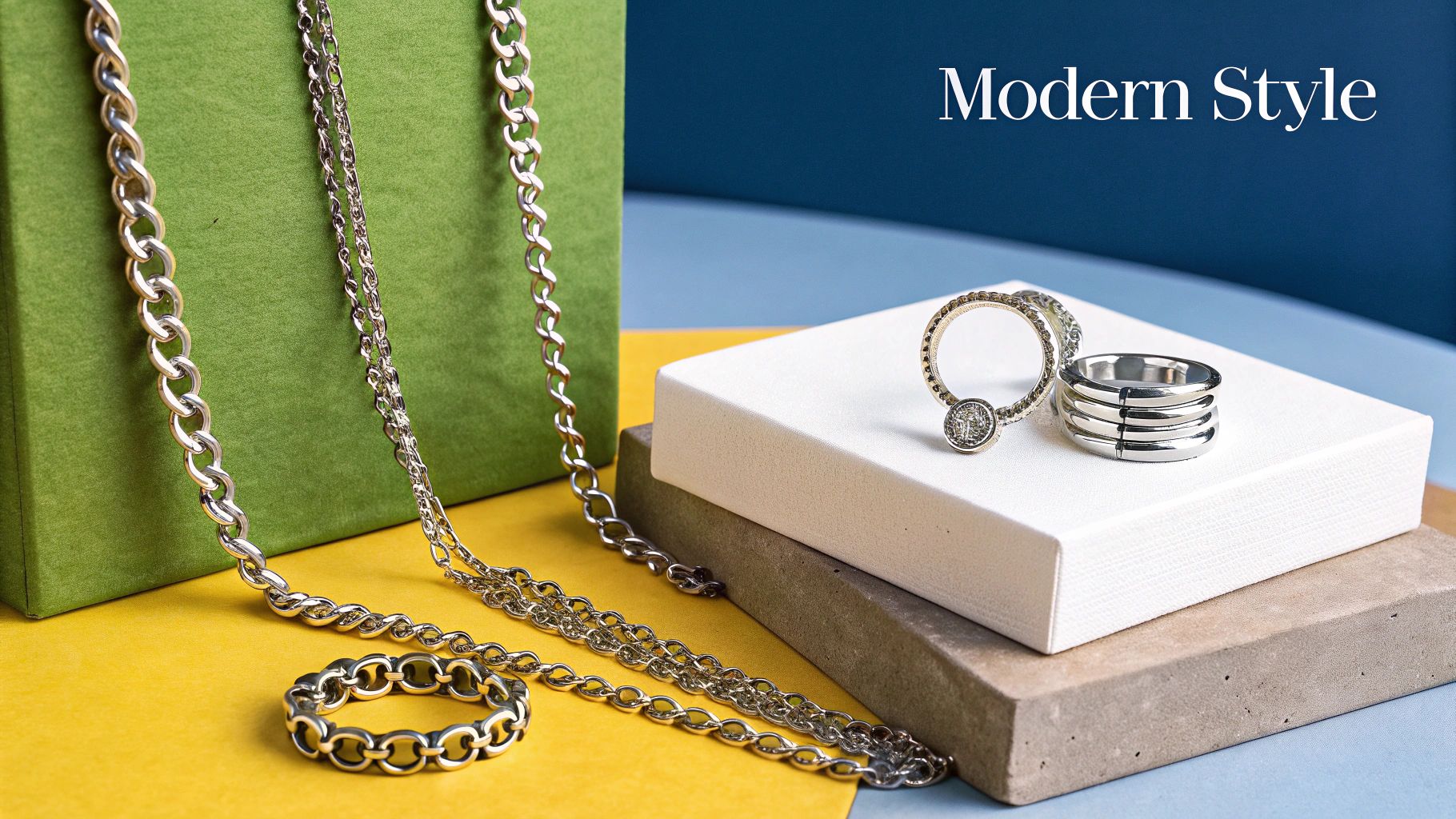
Let's be honest: choosing durable jewelry used to feel like a compromise. Not anymore. Today, the biggest accessory trends are built on a foundation of practicality and longevity, where the best tarnish-free jewelry isn't just a smart choice—it's the fashionable one.
This shift has pushed materials like stainless steel and titanium straight into the spotlight. Their incredible versatility means they can be crafted into the delicate, layered necklaces, chunky stackable rings, and minimalist hoops that dominate our feeds. These are the pieces you see everywhere for a reason: they perfectly blend chic design with real-world resilience.
The Rise of Effortless, Everyday Style
Modern life is busy. We value accessories that simplify our routines, not complicate them. This "get-up-and-go" mindset has fueled trends like "permanent jewelry"—those delicate chains welded right onto the wrist or ankle for continuous, worry-free wear. The entire concept hinges on tarnish-free materials that can handle life without turning or fading.
This demand for low-maintenance elegance has also kicked off a market boom. The wholesale and dropship space for non-tarnish jewelry is seeing explosive growth, with an expected annual growth rate of 11.3% as of 2025. It's all driven by affordable, durable pieces that fit a global desire for self-care and hassle-free style.
The appeal is simple: invest in a piece you love and wear it without a second thought. Tarnish-free jewelry fits seamlessly into a packed schedule, going from a morning workout to an evening out without ever losing its luster.
This philosophy of effortless style makes practical pieces, like our stainless steel collection, a perfect investment. You get a contemporary look that lasts, without the constant anxiety that your favorite accessories are one shower away from ruin.
How Durability Drives Fashion Forward
The strength and adaptability of tarnish-free metals give designers incredible creative freedom. They can create bold, intricate styles—from chunky chains to detailed pendants—that remain accessible to everyone, not just those who can afford solid precious metals. This democratic approach allows trends to circulate faster and lets more people participate in them.
For a great example of how this works in practice, check out this article on the comeback of long pendant necklaces. This trend shows how statement pieces made from durable metals are becoming essential parts of a modern wardrobe.
Ultimately, it’s this fusion of high style and everyday substance that makes these accessories so relevant right now.
Answering Your Top Questions About Tarnish-Free Jewelry
Diving into the world of durable jewelry can feel like learning a new language. To make sure everything is crystal clear, we've put together answers to the most common questions we get about finding and caring for the best tarnish-free pieces.
Think of this as your final cheat sheet. It’s here to lock in what you've learned and empower you to shop with total confidence. Once you're done, you'll be able to spot quality from a mile away and choose jewelry that’s genuinely built to last.
Is Stainless Steel Jewelry Actually Waterproof?
Yes, high-quality stainless steel—especially grades like 316L—is incredibly water-resistant. You don't have to worry about it rusting or tarnishing from everyday water contact, like washing your hands, showering, or even breaking a sweat at the gym.
Now, while it’s tough as nails, it’s always smart to give it a quick rinse with fresh water after a dip in a heavily chlorinated pool or the ocean. That simple step washes away any lingering chemical residue and keeps your jewelry looking brand new for years.
What Is the Difference Between Gold-Plated and Gold-Filled Jewelry?
This is a big one, and the difference comes down to how much gold is used and how it’s applied. Getting this right is the key to managing your expectations for how long a piece will last.
- Gold-Plated: Imagine a whisper-thin layer of gold electrically bonded to a base metal like brass or copper. It’s a fantastic, budget-friendly way to get that golden shine, but because the layer is so delicate, it can wear away with frequent use, eventually revealing the metal underneath.
- Gold-Filled: This is a whole different ballgame. A much, much thicker layer of gold is heat-bonded to a base metal core. By law, the gold must make up at least 5% of the item's total weight. The result is a durable, tarnish-resistant piece that’s the closest you can get to solid gold without the hefty price tag.
Can Tarnish-Free Jewelry Still Cause Skin Allergies?
Yes, a piece's ability to resist tarnish is a separate issue from whether it will cause an allergic reaction. The culprit behind allergies is almost always the specific metal used, not its resistance to discoloration.
The good news? Many of the best tarnish-free materials are naturally great for sensitive skin.
For instance, metals like titanium and surgical-grade stainless steel are famous for being hypoallergenic. The real risk often comes from poorly made plated pieces where the base metal contains nickel—one of the most common skin allergens out there. To be safe, always shop for jewelry that’s clearly labeled "nickel-free" or "hypoallergenic."
How Can I Tell if a Piece Is Truly Tarnish-Resistant Before Buying?
A good, trustworthy seller will never hide what their jewelry is made of. The best way to check for quality is to look for clues that show they're confident in their product.
First, dig into the product description. You want to see specific terms like "316L stainless steel," "titanium," or "925 sterling silver with rhodium plating." Vague descriptions like "metal alloy" should make you pause. Next, check the piece itself for tiny stamps, usually hidden on the clasp or an inside edge.
Finally, let other shoppers do the heavy lifting for you. Customer reviews are your best friend here. Look for comments from people who have worn the jewelry for weeks or months—their real-world feedback is the most honest test of how a piece truly holds up over time.
Now that you know exactly what to look for in beautiful, lasting accessories, it’s time to find your next go-to piece. At Precious Pulse Jewelry, we take pride in creating stunning collections of stylish, affordable, and durable jewelry designed to keep up with your life. Explore our new arrivals today!


